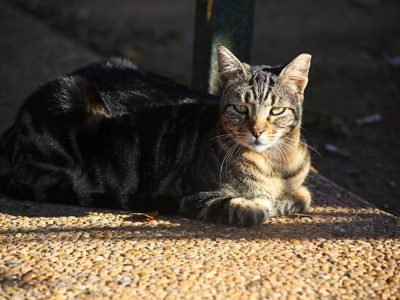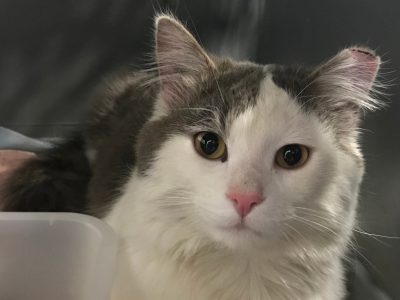Donations for TNR
Successfully executing TNR cases throughout Alberta takes resources, time and strategic planning. Donations are greatly appreciated to help cover the costs of the surgery.
Assisting People and Pets Affected by Wildfire Evacuations
The Edmonton Humane Society (EHS) is supporting the City of Edmonton to assist people and pets who have been evacuated to Edmonton due to the wildfires.

Cat colonies when left unmanaged can grow rapidly, making it difficult to control without outside help.
Trap Neuter Return (TNR) programs benefit both community cats and people as the most cost-effective, humane and successful method for managing these populations. Through TNR, community cats (feral or outdoor cats) are spayed or neutered, vaccinated, ear-tipped and are then returned to their outdoor home. Click here to learn more about how our TNR program works.
*Kittens of community cats may become socialized.
Outdoor, free-roaming cats are often as well-supported, fed and sheltered by community caregivers as the average indoor cat; therefore, are not in distress and should not be taken to pounds or shelters. Community cats are often afraid of humans and cannot easily be adopted, which means rehoming them would cause stress and not be the most humane option.

TNR supports the health of outdoor free-roaming cats, while allowing them to thrive in their preferred environment. If community cats are removed, resources are often still available, so new cats will move into the vacant territory and continue the cycle – making the return of altered cats a more sustainable and cost effective solution. Learn more about the benefits of TNR by clicking here.
To access a spay/neuter service for owned, companion cats, please check out our Prevent Another Litter Subsidy (PALS) program or contact your local veterinarian.

Property owners outside the City of Edmonton (up to 200 km) can allow community cats to continue to live peacefully while reducing overpopulation with our TNR program.
This program is designed for cats that are living outdoors and the intention is to release them back into the same location where they were trapped, with the expectation they will be supported by a community caregiver.
EHS is expanding its current program for 2024. Property owners can submit colony information to be considered for a future TNR clinic. Eligible colonies may receive support through no cost spay or neuter surgeries. EHS aims to provide:
The TNR program normally runs from May to September depending on the weather. There are a limited number of TNR Clinics available and colony information must be submitted in advance to be considered. EHS staff members may visit colonies and will require access to property to assist in the trapping process. Cats are returned to their original colony after recovering from surgery.
Please Note: We are unable to schedule appointments during extreme warm (above 20°C) and cold weather (below 0°C) as per Alberta Veterinary Medical Association (ABVMA) standards advising that cats should not be trapped in these conditions.
Have questions about our TNR program? Click here to visit our FAQ.
Note: Spaces are very limited, and weather impacts program delivery.


During this procedure, a small portion of the left ear is humanely removed. This is the universal symbol identifying a community cat has been spayed or neutered and has resources or caretakers nearby.
We are still collecting colony information to help target those requiring assistance. Please use the button below to request assistance.
We cannot accommodate all requests for assistance due to the high volume we receive but will endeavour to help as many as possible. We will keep all colonies on file and will assess requests for assistance in the spring of 2025.
Request TNR Program AssistanceThe TNR program cost is a $40 non-refundable admin fee. Fees are required once a colony is selected and you’re contacted by the TNR office. Successfully executing TNR throughout Alberta takes resources, time and strategic planning.
Donations are greatly appreciated to help cover costs.
No, this program typically operates from May to September, depending on weather conditions. In accordance with the Alberta Veterinary Medical Association (ABVMA) standards, appointments cannot be scheduled during extreme temperatures, which are below 0°C or above 20°C. These conditions are not suitable for trapping cats.
Colony caregivers are responsible for providing ongoing care, including food, water, shelter and monitoring for new intact cats or signs of illness or injury.
Cats have strong bonds to their birthplaces. TNR is an effective and humane method to manage community cat populations, improve their quality of life, reduce community issues and minimize euthanasia. It is in the best interest of the cat to return them to their original environment once they are vaccinated, microchipped and spayed/neutered.
Female cats can have up to three litters per year, contributing to the homeless cat population. TNR programs targeting a significant portion of a colony helps reduce the overall outdoor cat population by stabilizing it and causing a gradual decline.
TNR is available for community cats, which include both feral and more friendly cats who live outdoors and are considered unowned. For spay/neuter services for owned companion cats, please check out our Prevent Another Litter Subsidy (PALS) program or contact your local veterinarian.
Cats living outdoors naturally adapt to finding food, surviving in cold weather and forming a community, which is often supported by colony caregivers. TNR supports the health and well-being of these free-roaming outdoor cats in their preferred environment, offering a humane alternative to stress from human exposure and confinement or euthanasia.
Feral cats are not suitable as indoor pets due to stress from human exposure and confinement. However, feral kittens can be socialized with humans if removed from the colony before 12 weeks of age.
Community cats are not suitable as indoor pets due to stress and confinement. Euthanizing cats is ineffective as it does not address the root cause of overpopulation. Most often other cats will move in to take advantage of resources that are made available when the original cats from that community are removed entirely. TNR is a humane strategy to manage community cat populations while improving their lives and reducing euthanasia rates.
Community cat colonies often result from human neglect and abandonment. Managing the community cat population in a humane way is crucial to address this issue.
For more detailed information on TNR, videos and for step-by-step guides, please visit Alley Cat Allies or Neighborhood Cats.